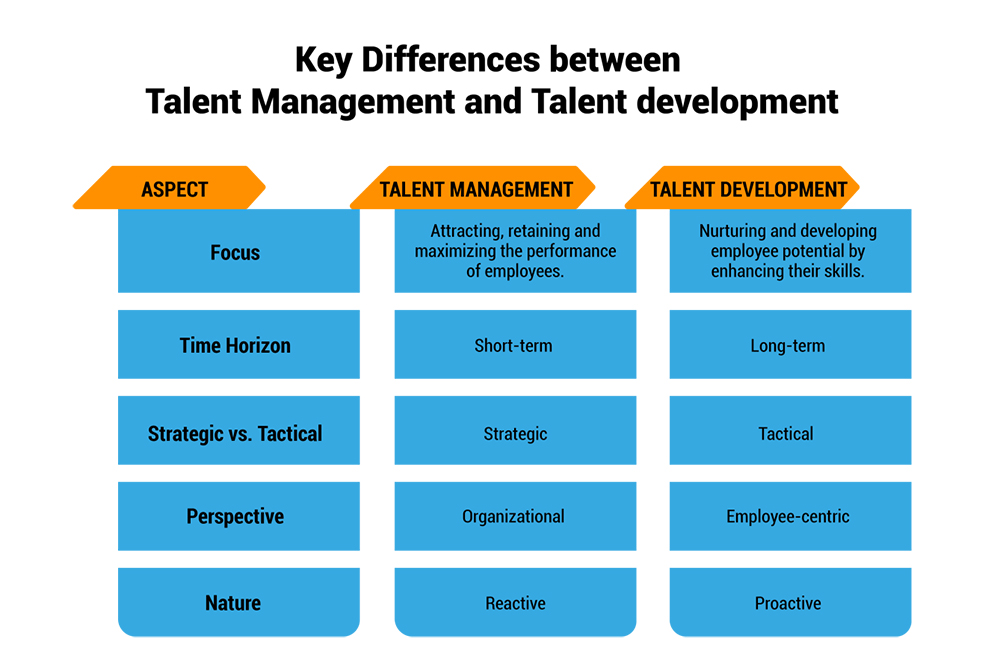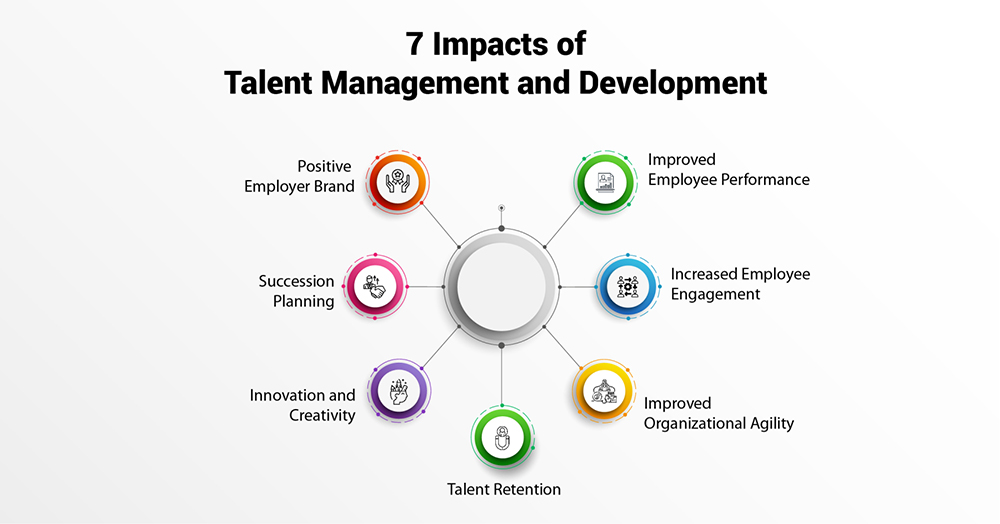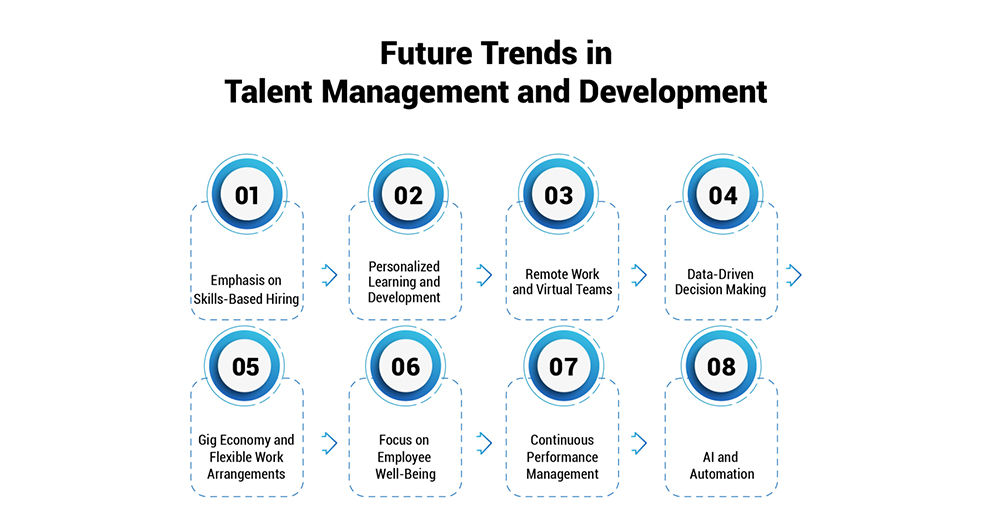
Talent management and talent development are pivotal components of organizational success, yet they are often confused or used interchangeably. Talent management involves the strategic process of attracting, retaining, and developing employees to meet current and future organizational needs. It focuses on recognizing employees as valuable assets and creating an environment where they can thrive. Conversely, talent development emphasizes enhancing employee skills and capabilities through various learning and growth opportunities.
It is essential for organizations to understand the distinctions between talent management and talent development to effectively manage their workforce. Talent management aligns people with business objectives, while talent development focuses on individual employee growth and potential.
In this blog, we will explore the key differences between talent management and talent development, highlighting their significance, challenges, and future trends. Through this discussion, we aim to provide a comprehensive understanding of how these concepts contribute to organizational success and how they can be leveraged to drive growth and innovation in any workplace.
Talent Management vs. Talent Development
Talent Management
Talent management is all about how a company attracts, retains, and develops its employees. It's like nurturing a garden, where each plant represents a valuable employee. This approach involves everything from recruiting the right people for the right roles to helping them grow and succeed within the organization.
At its core, talent management is about recognizing that employees are not just workers but valuable assets who can drive the company's success. It's about creating a positive work environment where employees feel valued, supported, and motivated to do their best.
It is a strategic process that focuses on ensuring the organization has the right people in the right roles at the right time. It's about investing in your employees' growth and development to help them reach their full potential, which in turn, benefits the organization as a whole.
Talent Development
Talent development is an important process aimed at enhancing the skills, knowledge, and capabilities of employees to drive individual and organizational growth. It involves creating a conducive environment for continuous learning and improvement through various initiatives such as training programs, mentoring, and career development opportunities.
It is about investing in human capital to foster a high-performing workforce. By providing employees with the tools and resources they need to succeed, organizations can improve employee engagement, retention, and productivity.
Talent development is not a one-size-fits-all approach. It should be tailored to meet the unique needs and aspirations of each individual employee. This personalized approach not only helps employees reach their full potential but also contributes to the overall success of the organization.
It is a critical component of effective talent management. Organizations that prioritize talent development are more likely to attract, retain, and develop top talent.
Key Differences Between Talent Management and Talent Development
Talent management and talent development are two critical components of human resource management, each with its distinct focus and objectives. Understanding the differences between the two is essential for organizations to effectively manage and develop their workforce.
Focus and Scope
-
Talent management encompasses the strategic processes involved in attracting, retaining, and optimizing the performance of employees to meet current and future organizational needs. It includes activities such as workforce planning, recruitment, performance management, and succession planning.
-
Talent development, on the other hand, focuses on the long-term growth and success of employees. It involves providing learning and development opportunities, such as training programs, mentoring, and coaching, to enhance employee skills, knowledge, and capabilities.
Time Horizon
-
Talent management typically has a shorter time horizon. It focuses on immediate talent needs and addressing current challenges within the organization.
-
Talent development takes a longer-term view. It aims to build a skilled and adaptable workforce that can meet future challenges and drive organizational growth.
Strategic vs. Tactical
-
Talent management is often seen as a strategic function. It helps in aligning talent strategies with overall business objectives and goals.
-
Talent development is more tactical as it focuses on implementing specific programs and initiatives to develop employee skills and capabilities.
Employee vs. Organizational Perspective
-
Talent management is primarily focused on the organization's needs. It makes sure that it has the right people in the right roles to achieve its goals.
-
Talent development takes a more employee-centric approach. It focuses on helping individual employees reach their full potential and achieve their career goals.
Reactive vs. Proactive
-
Talent management can be reactive, responding to immediate talent needs and challenges as they arise.
-
Talent development is proactive, anticipating future talent needs and preparing employees to meet those needs through ongoing learning and development initiatives.
While talent management and talent development are closely related, they serve different purposes within an organization. Talent management focuses on meeting immediate talent needs and managing employees, while talent development is about nurturing and developing employee skills and potential for long-term organizational success. A holistic approach that integrates both talent management and talent development is essential for organizations to build a strong and sustainable workforce.
A table summarizing the key differences between talent management and talent development is given below:

Impact of Effective Talent Management and Development
Effective talent management and development practices are fundamental to organizational success, driving performance, engagement, and innovation. By strategically investing in their workforce, organizations can create a competitive advantage and achieve sustainable growth.

-
Improved Employee Performance
Employees who receive continuous development opportunities are more motivated and engaged. This leads to higher productivity and quality of work. This ultimately enhances organizational performance and competitiveness.
-
Increased Employee Engagement
Talent management and development initiatives that focus on employee growth and well-being contribute to higher levels of engagement and job satisfaction. Engaged employees are more likely to stay with the organization, reducing turnover costs and retaining valuable talent.
-
Improved Organizational Agility
A well-developed workforce is more adaptable to change and better equipped to respond to evolving business needs. Effective talent management and development enable organizations to quickly pivot and capitalize on new opportunities.
-
Talent Retention
Investing in talent development demonstrates a commitment to employees' long-term growth and success. This fosters loyalty and retention, reducing the need for costly recruitment and onboarding processes.
-
Innovation and Creativity
A culture that values learning and development encourages employees to think creatively and innovate. By nurturing talent, organizations can discover new ideas and drive continuous improvement.
-
Succession Planning
Talent management and development initiatives identify high-potential employees and groom them for future leadership roles. This ensures a steady pipeline of qualified candidates and smooth transitions in key positions.
-
Positive Employer Brand
Organizations that prioritize talent management and development are seen as desirable employers. A positive employer brand attracts top talent and increases the organization's reputation in the marketplace.
Challenges in Talent Management and Development
While talent management and development are crucial for organizational success, they come with their own set of challenges. Addressing these challenges is essential for making sure that talent management and development initiatives are effective and impactful.
Some common pitfalls are as follows:
-
Identifying and Retaining Top Talent
One of the biggest challenges in talent management is identifying and retaining top talent. With the job market becoming increasingly competitive, attracting and keeping top performers can be a daunting task.
-
Developing a Comprehensive Talent Strategy
Many organizations struggle to develop a comprehensive talent strategy that aligns with their business goals. Without a clear strategy, talent management efforts may lack direction and fail to deliver desired results.
-
Balancing Short-Term and Long-Term Goals
Talent management and development require balancing short-term needs with long-term goals. While it's important to address immediate talent needs, organizations must also invest in developing talent for the future.
-
Providing Adequate Development Opportunities
Offering development opportunities is crucial for employee growth and retention. However, providing these opportunities can be challenging, especially for organizations with limited resources.
-
Keeping Up with Technological Advancements
Technology is rapidly changing the way we work, and organizations must keep pace with these advancements. Integrating new technologies into talent management and development processes can be challenging but is essential for staying competitive.
-
Creating a Culture of Continuous Learning
Developing a culture of continuous learning is key to talent development. However, changing mindsets and behaviors to prioritize learning can be a significant challenge for organizations.
-
Measuring the Effectiveness of Talent Management Initiatives
Measuring the effectiveness of talent management initiatives is crucial for identifying areas of improvement. However, many organizations struggle to establish metrics that accurately capture the impact of these initiatives.
-
Adapting to Changing Demographics and Workforce Trends
The workforce is becoming increasingly diverse, with different generations and demographics having unique needs and expectations. Adapting talent management and development strategies to meet these diverse needs can be challenging.
Future Trends in Talent Management and Development
The landscape of talent management and development is constantly evolving, driven by technological advancements, demographic shifts, and changing employee expectations. To stay ahead, organizations must anticipate and adapt to these future trends.

The key trends shaping the future of talent management and development:
-
Emphasis on Skills-Based Hiring
In the future, organizations will focus more on hiring based on skills rather than traditional qualifications. This shift will require a more dynamic approach to talent management, with a focus on identifying and developing key skills within the workforce.
-
Personalized Learning and Development
As employees seek more personalized learning experiences, organizations will need to tailor their development programs to meet individual needs. This could include personalized learning paths, mentoring programs, and on-the-job training.
-
Remote Work and Virtual Teams
The rise of remote work and virtual teams will continue to impact talent management and development. Organizations will need to find new ways to engage and develop remote employees, leveraging technology to facilitate collaboration and learning.
-
Data-Driven Decision Making
Data analytics will play a larger role in talent management and development. It will help organizations make more informed decisions about recruitment, performance management, and learning initiatives. This will require a focus on collecting and analyzing relevant data to drive strategy.
-
Gig Economy and Flexible Work Arrangements
The gig economy and flexible work arrangements will require organizations to rethink their approach to talent management. This could include strategies for managing a mix of full-time employees, freelancers, and contractors, as well as providing development opportunities for this diverse workforce.
-
Focus on Employee Well-Being
Employee well-being will become a top priority for organizations, with a focus on creating a supportive work environment that promotes physical, mental, and emotional health. This could include wellness programs, flexible work schedules, and initiatives to reduce stress and burnout.
-
Continuous Performance Management
Traditional performance management practices will give way to more continuous and feedback-driven approaches. This will require a shift towards regular check-ins, real-time feedback, and ongoing development conversations between managers and employees.
-
AI and Automation
AI and automation will continue to impact talent management and development, with AI-powered tools helping to streamline recruitment processes, personalize learning experiences, and identify skill gaps within the workforce.
Conclusion
Talent management and talent development are pivotal for organizational success, each with its unique focus and impact. Talent management emphasizes attracting, retaining, and optimizing employee performance, akin to nurturing a garden where each employee represents a valuable asset. Conversely, talent development centres on enhancing employees' skills and knowledge to drive individual and organizational growth, fostering a culture of continuous learning and improvement.
A holistic approach that integrates both talent management and talent development is crucial for organizations to thrive. By investing in their workforce's growth and development, organizations can enhance employee performance, engagement, and innovation, ultimately driving long-term success. Additionally, staying abreast of future trends, such as skills-based hiring, personalized learning, and remote work, will enable organizations to adapt and succeed in the evolving landscape of talent management and development.
Overall, talent management and talent development are not just HR functions but strategic imperatives that can propel organizations toward sustainable growth and competitiveness.





